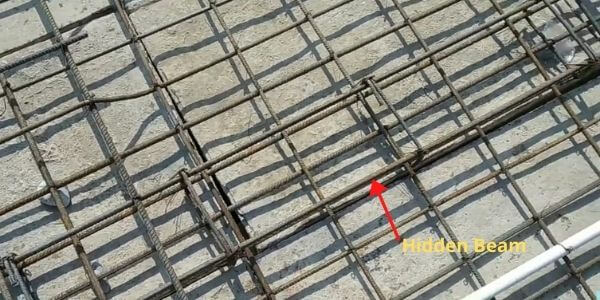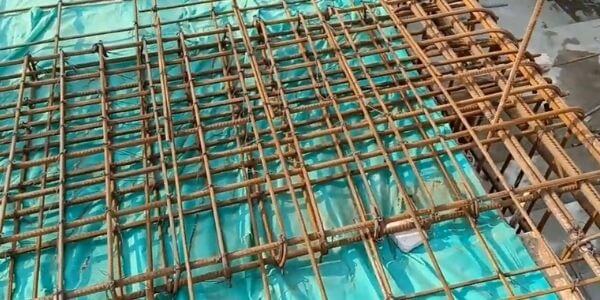Table of Contents
What is Hidden Beam?
An RCC beam is provided within the slab, which depth is equal to the slab depth refers to the hidden beam. It also refers to a flat beam or concealed beam.
The hidden beam forms an integral part of the frame structure and is usually used.
Due to strict and rigid architectural considerations, hidden beams come into existence. The load, which might be a brick wall, can be transferred without compromising the floor height by providing a hidden beam.
Today in this post, we will discuss the different aspects of reinforced cement concrete beam.
Why is it used?
The concept of a hidden beam comes from a flat slab. Mainly concealed beams are provided to transfer the concentrated wall load on the slab to the supporting beam and column.
Where is it Used in Buildings?

Concealed beams usually are used within the suspended slabs of considerable thickness where the slab span is significant.
It is also used when, due to architectural consideration, we can’t compromise the height of the floor, and we can’t provide a high depth beam.
Concealed beams are suitable to transfer the concentrated load of the wall on a slab to the supporting beam and column of the structure.
The concealed beam is given between living and dining areas, at a right angle to each other, hall and verandah. It provides a clean and level ceiling surface that gives a better appearance.
Also, Read - Sunken Slab - Uses, Advantages And Disadvantages
How to Design a Hidden Beam?

The design of a concealed beam is similar to regular beams except for depth. Its depth is defined and shouldn’t be more significant than slab thickness.
Hence it is necessary to increase the ratio of reinforcement and width to conquer this restriction to a specific limit.
Although a concealed beam has a similar depth to a slab, it reinforced separately with longitudinal bars and stirrups like a regular beam, and once the slab cast, it disappears.
For designing a concave beam analysis of beam and model with whole slab is necessary.
Purpose of Hidden Beam

- It is suitable to distribute the concentrated load of the wall imposed on the slab.
- It permits the use of the slab of a greater span.
- It is appropriate when the architectural aesthetic is essential for the interior of the building.
- It helps to break the extensive slab panel into considerable size.
- It helps to achieve the desired floor height.
- It allows brickwork over the slab.
- It helps to provide an easy path for ductwork.
Also, Read - Difference Between Singly and Doubly Reinforced Beam
Advantages of Hidden Beams
Concealed beams are desired structural component because of their several benefits, which include:
- It saves on floor height clearance
- It provides the economy by keeping the cost of formwork, labour, and materials
- It gives a plane ceiling surface that provides an acceptable aesthetic appearance, which helps in efficient interior work
- Concealed beam offers a simple path for electromechanical ductwork
Disadvantages of Hidden Beam
- The concealed beam’s problem is that it has considerably low flexibility due to the high reinforcement ratio provided to overcome depth restriction, specifically at column connection.
- Concealed bema creates a spanning problem since spans for structural support are at a right angle to each other. That means one slab structurally rests over the other.
- It is not capable to take lateral loads.
I hope know you have enough information about hidden beam.
Thanks!
Also, Read
What is Plinth Beam? Plinth Protection, Difference Between Plinth Beam and Tie Beam
How to Calculate Quantity of Steel in One way Slab?
Cracks in Concrete Slab – Why do they develop after Casting?
Difference Between Beam and Column
What is Concrete Cover – Clear Cover, Nominal Cover and Effective Cover
What is Column? – Types of Column, Reinforcement and Design Procedure
Plum Concrete – Purpose, Ratio, Specification and Uses